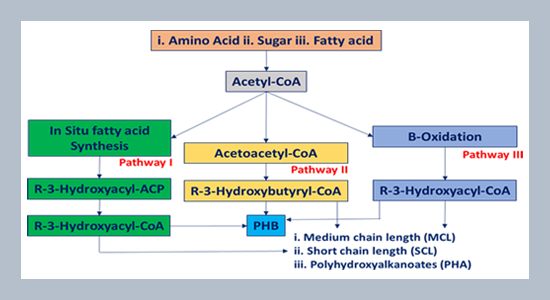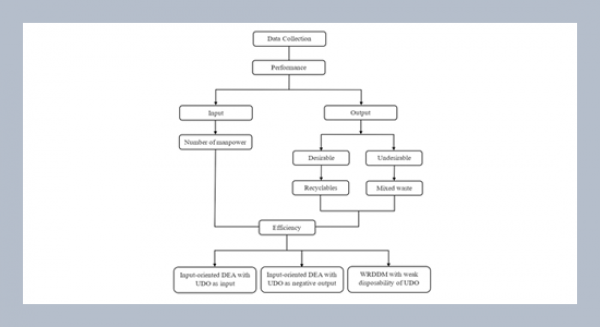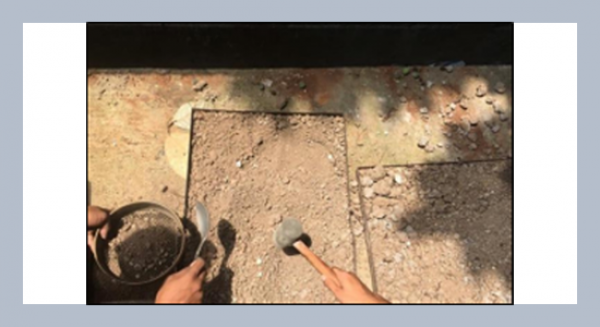REFERENCES
- Aluru, R.R., 2020. Screening and biochemical characterization of PHB producing bacterium isolated from costal region of Andhra Pradesh. Environmental and Earth Sciences Research Journal, 7(3), 116–120.
- Anjali, M., Sukumar, C., Kanakalakshmi, A., Shanthi, K. 2014. Enhancement of growth and production of polyhydroxyalkanoates by Bacillus subtilis from agro-industrial waste as carbon substrates. Composite Interfaces, 21(2), 111–119.
- Aryaraj, D., Pramitha, V. S. 2021. Extraction and characterization of Polyhydroxybutyrate (PHB) from Bacillus flexus MHO57386.1 isolated from marine sponge Oceanopia arenosa (Rao, 1941). Marine Science and Technology Bulletin, 10(2), 170–185.
- Ashby, R.D., Solaiman, D.K., Strahan, G.D. 2011. Efficient utilization of crude glycerol as fermentation substrate in the synthesis of poly (3-hydroxybutyrate) biopolymers. Journal of the American Oil Chemists' Society, 88, 949–959.
- Bhatia, S.K., Yoon, J.J., Kim, H.J., Hong, J.W., Hong, Y.G., Song, H.S., Moon, Y.M., Jeon, J.M., Kim, Y.G., Yang, Y.H. 2018. Engineering of artificial microbial consortia of Ralstonia eutropha and Bacillus subtilis for poly (3-hydroxybutyrate-co-3-hydroxyvalerate) copolymer production from sugarcane sugar without precursor feeding. Bioresource technology, 257, 92–101.
- Bhuwal, A.K., Singh, G., Aggarwal, N.K., Goyal, V., Yadav, A. 2013. Isolation and screening of polyhydroxyalkanoates producing bacteria from pulp, paper, and cardboard industry wastes. International Journal of Biomaterials, 2013, 752821.
- Cho, S. L., Jung, M. Y., Park, M. H., Kim, W. 2010. Bacillus chungangensis sp. nov., a halophilic species isolated from sea sand. International Journal of Systematic and Evolutionary Microbiology, 60(6), 1349–1352.
- Choi, T.R., Jeon, J.M., Bhatia, S.K., Gurav, R., Han, Y.H., Park, Y.L., Park, J.Y., Song, H.S., Park, H.Y., Yoon, J.J., Seo, S.O. 2020. Production of low molecular weight P(3HB-co-3HV) by butyrateacetoacetate CoA-transferase (cftAB) in Escherichia coli. Biotechnology and bioprocess engineering, 25, 279–286.
- Dalsasso, R.R., Pavan, F.A., Bordignon, S.E., de Aragão, G.M.F., Poletto, P. 2019. Polyhydroxybutyrate (PHB) production by Cupriavidus necator from sugarcane vinasse and molasses as mixed substrate. Process Biochemistry, 85, 12–18.
- Danial, A.W., Hamdy, S.M., Alrumman, S.A., Gad El-Rab, S.M., Shoreit, A.A., Hesham, A.E.L. 2021. Bioplastic production by Bacillus wiedmannii AS-02 OK576278 using different agricultural wastes. Microorganisms, 9(11), 2395.
- Dawoud, T.M., Alharbi, N.S., Theruvinthalakal, A.M., Thekkangil, A., Kadaikunnan, S., Khaled, J.M., Rajaram, S.K. 2020. Characterization and antifungal activity of the yellow pigment produced by a Bacillus sp. DBS4 isolated from the lichen Dirinaria agealita. Saudi Journal of Biological Sciences, 27(5), 1403–1411.
- Desouky, S.E.S., Abdel-Rahman, M.A., Azab, M.S. and Esmael, M.E. 2017. Batch and fed-batch production of polyhydroxyalkanoates from sugarcane molasses by Bacillus flexus Azu-A2. Journal of Innovations in Pharmaceutical and Biological Sciences, 4, 55–66.
- Dhangdhariya, J.H., Dubey, S., Trivedi, H.B., Pancha, I., Bhatt, J.K., Dave, B.P., Mishra, S. 2015. Polyhydroxyalkanoate from marine Bacillus megaterium using CSMCRI's dry sea mix as a novel growth medium. International Journal of Biological Macromolecules, 76, 254–261.
- El-Sheekh, M.M., El-Abd, M.A., El-Diwany, A.I. 2015. Poly-3 hydroxybutyrate production by Bacillus flexusME-77 using some industrial wastes. Rendiconti Lincei, 26(2), 109–119.
- Endres, H.J. 2017. Bio-based thermoplastic and thermosets polymer. Lightweight and Sustainable Materials for Automotive Applications, CRC Press, 139–166.
- Getachew, A., Woldesenbet, F. 2016. Production of biodegradable plastic by polyhydroxybutyrate (PHB) accumulating bacteria using low-cost agricultural waste material. BioMed Central Research Notes, 9, 1–9.
- Gowda, V., Shivakumar, S. 2014. Agrowaste-based Polyhydroxyalkanoate (PHA) production using hydrolytic potential of Bacillus thuringiensis IAM 12077. Brazilian Archives of Biology and Technology, 57, 55–61.
- Han, J., Wu, L.P., Hou, J., Zhao, D. and Xiang, H. 2015. Biosynthesis, characterization,and hemostasis potential of tailor-madepoly (3-hydroxybutyrate-co-3-hydroxyvalerate) produced by Haloferax mediterranei. Biomacromolecules, 16(2), 578–588.
- Hong, K., Sun, Y., Tian, X., Chen, D., Zhou, J., Huang, W. 2019. Production of poly-hydroxybutyrate (PHB) by Halomonas sp. LY-01 using mixed carbon sources and its characterization. International Journal of Biological Macromolecules, 136, 706–711.
- Joseph, J. and Chithira, O.S., 2021. Characterisation of polyhydroxy Butyrate (PHB) from Bacillus subtilis strain P isolated from rhizosphere soil. InternationalJournal of Current Microbiology and Applied Sciences, 10(01), 3004–3014.
- Juengert, J.R., Bresan, S., Jendrossek, D. 2018. Determination of polyhydroxybutyrate (PHB) content in Ralstonia eutropha using gas chromatography and Nile red staining. Bio-protocol, 8(5), e2748.
- Kalaivani, R., Sukumaran, V. 2015. Enhancement of technique for optimized production of PHA frommarine bacteria, utilizing cheaply available carbonsources at Thanjavur district, India. International Journal of Current Microbiology and Applied Sciences, 4(4), 408–417.
- Kazi, Z., Hungund, B.S., Yaradoddi, J.S., Banapurmath, N.R., Yusuf, A.A., Kishore, K.L., Soudagar, M.E.M., Khan, T.M., Elfasakhany, A. and Buyondo, K.A. 2022. Production, characterization, and antimicrobial activity of pigment from streptomyces species. Journal of Nanomaterials, 2022, 3962301.
- Koch, M., Doello, S., Gutekunst, K., Forchhammer, K. 2019. PHB is produced from glycogen turn-over during nitrogen starvation in Synechocystis sp. PCC 6803. International Journal of Molecular Sciences, 20(8), 1942.
- Korumilli, T., Mishra, S. 2014. Carotenoid production by Bacillus clausii using rice powder as the sole substrate: Pigment analyses and optimization of key production parameters. Journal of Biochemical Technology, 5(4), 788–794.
- Kourmentza, C., Plácido, J., Venetsaneas, N., Burniol-Figols, A., Varrone, C., Gavala, H.N., Reis, M.A. 2017. Recent advances and challenges towards sustainable polyhydroxyalkanoate (PHA) production. Bioengineering, 4(2), 55.
- Krueger, C.L., Radetski, C.M., Bendia, A.G., Oliveira, I.M., Castro-Silva, M.A., Rambo, C.R., Lima, A.O. 2012. Bioconversion of cassava starch by-product into Bacillus and related bacteria polyhydroxyalkanoates. Electronic Journal of Biotechnology, 15(3), 8–8.
- Kumalaningsih, S., Hidayat, N., Aini, N. 2011. Optimization of polyhydroxyalkanoates (PHA) production from liquid bean curd waste by Alcaligenes latus bacteria. Journal of Agricultural Food Technology, 1, 63–67.
- Kumar, V., Darnal, S., Kumar, S., Kumar, S., Singh, D. 2021. Bioprocess for co-production of polyhydroxybutyrate and violacein using Himalayan bacterium Iodobacter sp. PCH194. Bioresource Technology, 319, 124235.
- Lamberti, F.M., Román-Ramírez, L.A., Wood, J. 2020. Recycling of bioplastics: routes and benefits. Journal of Polymers and the Environment, 28, 2551–2571.
- Law, J.H., Slepecky, R.A. 1961. Assay of poly-β-hydroxybutyric acid. Journal of Bacteriology, 82(1), 33–36.
- Liu, Y., Huang, S., Zhang, Y., Xu, F. 2014. Isolation and characterization of athermophilic Bacillus shackletonii K5 from a biotrickling filter for the production of polyhydroxybutyrate. Journal of Environmental Sciences, 26(7), 1453–1462.
- Lu, W.K., Chiu, T.Y., Hung, S.H., Shih, L., Chang, Y.N., 2004. Use of response surface methodology to optimize culture medium for production of poly-γ-glutamic acid by Bacillus licheniformis. International Journal of Applied Science and Engineering, 2(1), 49–58.
- Mahitha, G., Madhuri, R. 2015. Purification and characterization of polyhydroxybutyrate produced from marine bacteria. International Journal of Scientific & Engineering Research, 6, 71–75.
- Mayeli, N., Motamedi, H., Heidarizadeh, F. 2015. Production of polyhydroxybutyrate by Bacillus axaraqunsis BIPC01 using petrochemical wastewater as carbon source. Brazilian Archives of Biology and Technology, 58, 643–650.
- McAdam, B., Brennan Fournet, M., McDonald, P., Mojicevic, M. 2020. Production of polyhydroxybutyrate (PHB) and factors impacting its chemical and mechanical characteristics. Polymers, 12(12), 2908.
- Moorkoth, D., Nampoothiri, K.M. 2016. Production and characterization of poly (3-hydroxy butyrate-co-3 hydroxyvalerate) (PHBV) by a novel halotolerant mangrove isolate. Bioresource Technology, 201, 253–260.
- Mostafa, Y.S., Alrumman, S.A., Otaif, K.A., Alamri, S.A., Mostafa, M.S., Sahlabji, T. 2020. Production and characterization of bioplastic by polyhydroxybutyrate accumulating Erythrobacteraquimaris isolated from mangrove rhizosphere. Molecules, 25(1), 179.
- Nair, A.M., Annamalai, K., Kannan, S.K., Kuppusamy, S. 2014. Utilization of sugarcane molasses for the production of polyhydroxyalkanoates using Bacillus subtilis. Malaya Journal of Bioscience, 1, 24–36.
- Numan, M., Bashir, S., Mumtaz, R., Tayyab, S., Rehman, N.U., Khan, A.L., Al-Harrasi, A. 2018. Therapeutic applications of bacterial pigments: a review of current status and future opportunities. 3 Biotech, 8, 1–15.
- Pallath, N., Francis, B., Devanesan, S., Farhat, K., Balakrishnan, M. 2023. Isolation and characterization of novel carotenoid pigment from marine Planococcus maritimus MBP-2 and their biological applications. Journal of King Saud University-Science, 35(8), 102872.
- Poomipuk, N., Reungsang, A., Plangklang, P. 2014. Poly-β-hydroxyalkanoates production from cassava starch hydrolysate by Cupriavidus sp. KKU38. International Journal of Biological Macromolecules, 65, 51–64.
- Pradhan, S., Dikshit, P.K., Moholkar, V.S. 2018. Production, ultrasonic extraction, and characterization of poly (3 hydroxybutyrate) (PHB) using Bacillus megaterium and Cupriavidus necator. Polymers for Advanced Technologies, 29(8), 2392–2400.
- Priya, M., Selvi, C.S., Kousalya, M. 2017. Screening for potential carotogenic producing bacteria from rhizospheric soil and it act as an antibacterial activity. World Journal of Pharmacy and Pharmaceutical Sciences, 6(12), 1033–1043.
- Ram, S., Mitra, M., Shah, F., Tirkey, S.R., Mishra, S. 2020. Bacteria as an alternate biofactory for carotenoid production: A review of its applications, opportunities and challenges. Journal of Functional Foods, 67, 103867.
- Ramezani, M., Amoozegar, M.A., Ventosa, A. 2015. Screening and comparative assay of poly-hydroxyalkanoates produced by bacteria isolated from the Gavkhooni Wetland in Iran and evaluation of poly-β-hydroxybutyrate production by halotolerant bacterium Oceanimonas sp. GK1. Annals of Microbiology, 65, 517–526.
- Ratnakaran, P., Bhoir, M., Durve-Gupta, A. 2020. Isolation and characterization of pigment producing bacteria isolated from waste. International Journal of Applied Research, 6(4), 252–260.
- Ratnawati, R., Hamidah, N.Y., Pradana, M.A. and Prasetyaningrum, A. 2024. Biodegradable plastic from cross-linked rice flour: Effect of cross-linking agent and plasticizer. International Journal of Applied Science and Engineering, 21(1), 2023061.
- Sabapathy, P.C., Devaraj, S., Parthiban, A., Pugazhendhi, A., Kathirvel, P. 2019. Aegle marmelos: A novel low-cost substrate for the synthesis of polyhydroxyalkanoate by Bacillus aerophilus RSL-7. Biocatalysis and Agricultural Biotechnology, 18, 101021.
- Sakthiselvan, P., Madhumathi, R. 2018. Kinetic evaluation on cell growth and biosynthesis of polyhydroxybutyrate (PHB) by Bacillus safensis EBT1 from sugarcane bagasse. Engineering in Agriculture, Environment and Food, 11(3), 145–152.
- Saratale, R.G., Saratale, G.D., Cho, S.K., Kim, D.S., Ghodake, G.S., Kadam, A., Shin, H.S. 2019. Pretreatment of kenaf (Hibiscus cannabinus L.) biomass feedstock for polyhydroxybutyrate (PHB) production and characterization. Bioresource Technology, 282, 75–80.
- Sathiyanarayanan, G., Bhatia, S.K., Song, H.S., Jeon, J.M., Kim, J., Lee, Y.K., Kim, Y.G., Yang, Y.H. 2017. Production and characterization of medium-chain-length polyhydroxyalkanoate copolymer from Arctic psychrotrophic bacterium Pseudomonas sp. PAMC 28620. International Journal of Biological Macromolecules, 97, 710–720.
- Sawant, S.S., Salunke, B.K., Kim, B.S., 2014. A laboratory case study of efficient polyhydoxyalkonates production by Bacillus cereus, a contaminant in Saccharophagus degradans ATCC 43961 in minimal sea salt media. Current Microbiology, 69, 832–838.
- Shah, K.R. 2014. Optimization and production of polyhydroxybutarate (PHB) by Bacillus subtilis G1S1 from soil. International Journal of Current Microbiology and Applied Sciences, 3(5), 377–387.
- Shah, K.R. 2012. FT-IR analysis of polyhydroxyalkanoates bynovel Bacillus sp. AS 3-2 from soil of Kadi region, North Gujarat, India. Journal of Biochemical Technology, 3(4), 380–383.
- Sharma, R., Ghoshal, G. 2021. Characterization and cytotoxic activity of pigment extracted from Rhodotorula mucilaginosa to assess its potential as bio-functional additive in confectionary products. Journal of Food Science and Technology, 58, 2688–2698.
- Sukan, A., Roy, I., Keshavarz, T. 2014. Agro-industrial waste materials as substrates for the production of poly (3-hydroxybutyric acid). Journal of Biomaterials and Nanobiotechnology, 5(4), 229–240.
- Suwannasing, W., Imai, T., Kaewkannetra, P. 2015. Cost-effective defined medium for the production of polyhydroxyalkanoates using agricultural raw materials. Bioresource Technology, 194, 67–74.
- Vila, E., Hornero-Méndez, D., Azziz, G., Lareo, C., Saravia, V. 2019. Carotenoids from heterotrophic bacteria isolated from fildes peninsula, king george island, antarctica. Biotechnology Reports, 21, e00306.
- Williams S. T., Goodfellow M., Alderson G. 1989. Bergey's Manual of Systematic Bacteriology, in Genus Streptomyces Waksman and Henrici, 1943, 339AL, Vol. 4.















